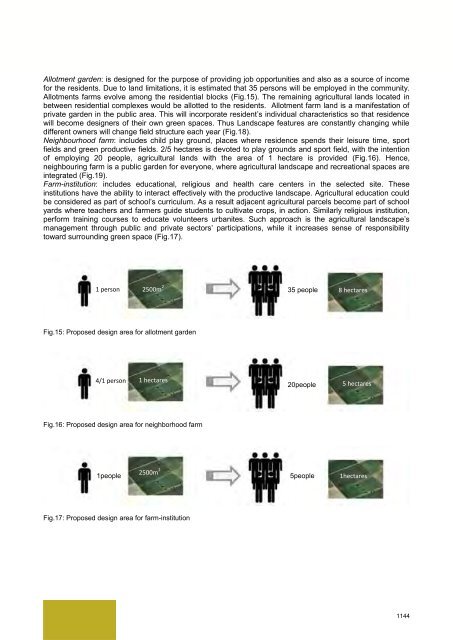Archaeology and nature: hyblean cultural landscape and territorial ...
Archaeology and nature: hyblean cultural landscape and territorial ...
Archaeology and nature: hyblean cultural landscape and territorial ...
Create successful ePaper yourself
Turn your PDF publications into a flip-book with our unique Google optimized e-Paper software.
Allotment garden: is designed for the purpose of providing job opportunities <strong>and</strong> also as a source of income<br />
for the residents. Due to l<strong>and</strong> limitations, it is estimated that 35 persons will be employed in the community.<br />
Allotments farms evolve among the residential blocks (Fig.15). The remaining agri<strong>cultural</strong> l<strong>and</strong>s located in<br />
between residential complexes would be allotted to the residents. Allotment farm l<strong>and</strong> is a manifestation of<br />
private garden in the public area. This will incorporate resident’s individual characteristics so that residence<br />
will become designers of their own green spaces. Thus L<strong>and</strong>scape features are constantly changing while<br />
different owners will change field structure each year (Fig.18).<br />
Neighbourhood farm: includes child play ground, places where residence spends their leisure time, sport<br />
fields <strong>and</strong> green productive fields. 2/5 hectares is devoted to play grounds <strong>and</strong> sport field, with the intention<br />
of employing 20 people, agri<strong>cultural</strong> l<strong>and</strong>s with the area of 1 hectare is provided (Fig.16). Hence,<br />
neighbouring farm is a public garden for everyone, where agri<strong>cultural</strong> l<strong>and</strong>scape <strong>and</strong> recreational spaces are<br />
integrated (Fig.19).<br />
Farm-institution: includes educational, religious <strong>and</strong> health care centers in the selected site. These<br />
institutions have the ability to interact effectively with the productive l<strong>and</strong>scape. Agri<strong>cultural</strong> education could<br />
be considered as part of school’s curriculum. As a result adjacent agri<strong>cultural</strong> parcels become part of school<br />
yards where teachers <strong>and</strong> farmers guide students to cultivate crops, in action. Similarly religious institution,<br />
perform training courses to educate volunteers urbanites. Such approach is the agri<strong>cultural</strong> l<strong>and</strong>scape’s<br />
management through public <strong>and</strong> private sectors’ participations, while it increases sense of responsibility<br />
toward surrounding green space (Fig.17).<br />
1 person 2500m 35 people<br />
2 8 hectares<br />
Fig.15: Proposed design area for allotment garden<br />
4/1 person<br />
Fig.16: Proposed design area for neighborhood farm<br />
1people<br />
1 hectares<br />
2500m 2<br />
Fig.17: Proposed design area for farm-institution<br />
20people<br />
5people<br />
5 hectares<br />
1hectares<br />
8 hectares<br />
1144
















